-
History of:
- Resources about:
- More:
- Baby walkers
- Bakehouses
- Bed warmers
- Beer, ale mullers
- Besoms, broom-making
- Box, cabinet, and press beds
- Butter crocks, coolers
- Candle snuffers, tallow
- Clothes horses, airers
- Cooking on a peat fire
- Drying grounds
- Enamel cookware
- Fireplaces
- Irons for frills & ruffles
- Knitting sheaths, belts
- Laundry starch
- Log cabin beds
- Lye and chamber-lye
- Mangles
- Marseilles quilts
- Medieval beds
- Rag rugs
- Rushlights, dips & nips
- Straw mattresses
- Sugar cutters - nips & tongs
- Tablecloths
- Tinderboxes
- Washing bats and beetles
- Washing dollies
- List of all articles
Subscribe to RSS feed or get email updates.
...When a foraging officer demanded of the wife of Jotham Townsend the keys of her corn-crib, and on her refusal drew his sword, she flourished an oven peel — for she was preparing to bake bread — at the representative of the Crown, and asked scornfully if he drew his sword upon women. The disconcerted officer smiled and was soon out of sight.
Elizabeth Fries Ellet, The Women of the American Revolution, 1848
...she came to an oven that stood in the path, full of warm, new-baked bread, one loaf whiter than the other, and a peel lying ready at the oven's mouth. The oven said: " Dear little maiden, do me no harm, a poor oven ! Eat as much as thou wishest, but take nothing with thee, and shove the remainder back into the oven." The girl begged it not to be afraid, for that she would certainly do it no harm. She then took the peel, opened the oven's mouth, drew out a warm, new-baked loaf, and began to eat; but having eaten as much as she required, she shoved in the remainder, closed the door of the oven, and restored the peel to its place; then continued her wandering. The oven cast a friendly look after her, and wished that all might go well with her in the world.
The Two Caskets, a Scandinavian folk tale
Bread peels
Oven peels, baker's shovels, bread paddles
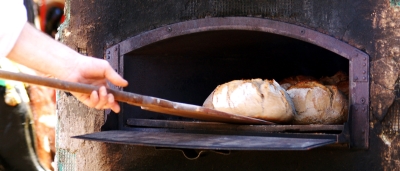 A peel is an ancient baking tool, yet
also completely modern. For thousands of years bakers have moved loaves in and out
of hot ovens on a long-handled shovel. 21st century urban people, even those with
no interest in cooking, may have seen this happening at a pizza restaurant.
A peel is an ancient baking tool, yet
also completely modern. For thousands of years bakers have moved loaves in and out
of hot ovens on a long-handled shovel. 21st century urban people, even those with
no interest in cooking, may have seen this happening at a pizza restaurant.
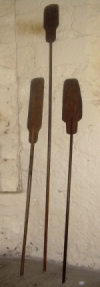 Peels, or baking paddles, have been
used in many different cultures, in different eras: in brick, stone, clay and metal
ovens. Today, fashionable peels for domestic baking may be made of shiny stainless
steel and have shorter handles, but the basic design has hardly changed.
Peels, or baking paddles, have been
used in many different cultures, in different eras: in brick, stone, clay and metal
ovens. Today, fashionable peels for domestic baking may be made of shiny stainless
steel and have shorter handles, but the basic design has hardly changed.
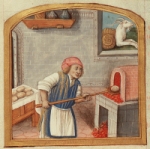 A two thousand year old sculpted
tomb in Rome (bottom left) shows a baker using his peel in just the same way as
the medieval baker illustrated on the right. Households with their own bread ovens
needed the same equipment; the three upright wooden peels (left) are displayed in
a 17th century Scottish kitchen. An
18th century peel in New England was made of iron. In mid-20th century New
Mexico, the bread was lifted with wood. (See below right)
A two thousand year old sculpted
tomb in Rome (bottom left) shows a baker using his peel in just the same way as
the medieval baker illustrated on the right. Households with their own bread ovens
needed the same equipment; the three upright wooden peels (left) are displayed in
a 17th century Scottish kitchen. An
18th century peel in New England was made of iron. In mid-20th century New
Mexico, the bread was lifted with wood. (See below right)
The technique has to be practised. Sliding lumps of dough neatly off a flat spade from a distance isn't easy, if you want your loaves to look good. Peels can also be used for non-bread cooking:
To broil Eggs.
After heating an Oven Peel red hot, blow off the Dust, break the Eggs on it, and put them into a hot Oven, or brown them on the Top with a red hot Fire-shovel...
The Lady's Companion, 1743
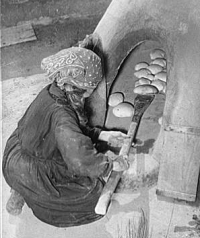 At home, women using peels for smaller-scale
domestic baking might find them handy weapons, just as they sometimes made use of
washing bats. Unlike laundry tools, however,
peels were also the symbol of a male trade or profession, and were important enough
to be included in certain coats of arms.
At home, women using peels for smaller-scale
domestic baking might find them handy weapons, just as they sometimes made use of
washing bats. Unlike laundry tools, however,
peels were also the symbol of a male trade or profession, and were important enough
to be included in certain coats of arms.
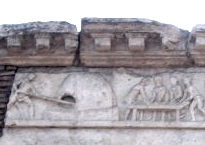 A baker's peel is traditionally
carried by St. Honoré
(Honorius) alongside his bishop's
crozier. His nurse laughed at his childhood hope of becoming a priest. That's
as likely as my oven peel growing leaves, she said. Then her bread shovel started
to sprout, and the rest you can guess. St. Honoré is the patron saint of bakers,
especially in France.
A baker's peel is traditionally
carried by St. Honoré
(Honorius) alongside his bishop's
crozier. His nurse laughed at his childhood hope of becoming a priest. That's
as likely as my oven peel growing leaves, she said. Then her bread shovel started
to sprout, and the rest you can guess. St. Honoré is the patron saint of bakers,
especially in France.
Alternative spellings include peal and pele.
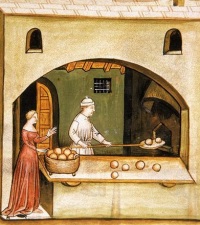 Other pages about bread and butter:
Other pages about bread and butter:
Bakehouses and community ovens
Flat bread and bannocks baked over a fire
Butter crocks
Butter churns
Also see:
Kneading troughs
and dough boxes
Kitchen antiques
 19 September 2007
19 September 2007
You may like our new sister site Home Things Past where you'll find articles about antiques, vintage kitchen stuff, crafts, and other things to do with home life in the past. There's space for comments and discussion too. Please do take a look and add your thoughts. (Comments don't appear instantly.)
For sources please refer to the books page, and/or the excerpts quoted on the pages of this website, and note that many links lead to museum sites. Feel free to ask if you're looking for a specific reference - feedback is always welcome anyway. Unfortunately, it's not possible to help you with queries about prices or valuation.


